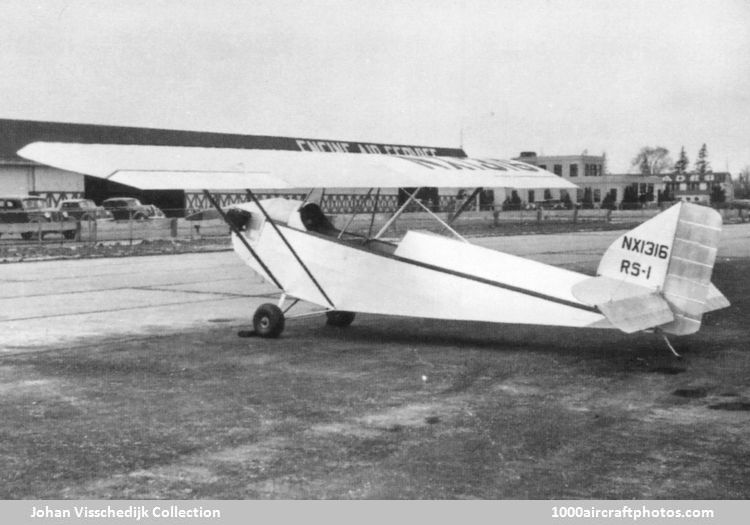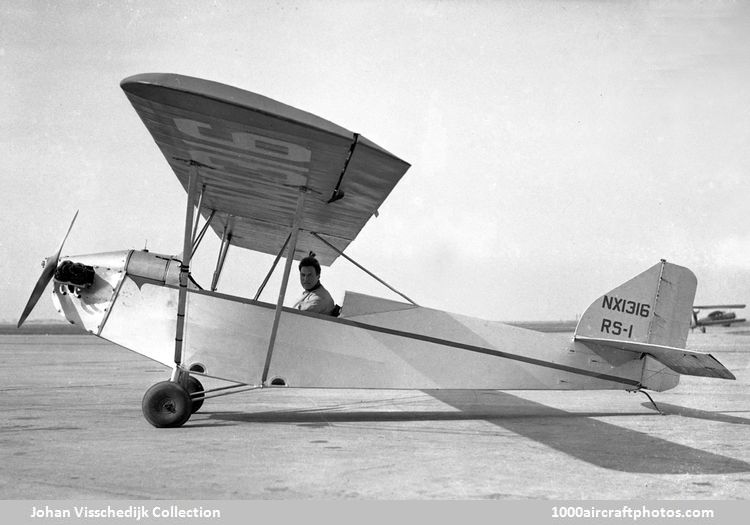Photographed at the New York Aviation Show, New York City, New York, USA, February 1947, source unknown
10/31/2023. Remarks by
Johan Visschedijk: "Before the USA became involved with WW II, Orrin E. Ross of Amityville, New York, designed a sport aircraft that could be operated on the lowest possible budget with very little maintenance, the low-cost RS-1 Parasol. After WW II it was upgraded to the RS-2L.
Ross RS-1 Parasol, initial (NX1316) (
Johan Visschedijk Collection)
The RS-1 was a strut-braced, high-winged monoplane with two seats in tandem in an open cockpit with a small windshield, solo flight from rear seat only. The slab-sided fuselage was built of welded steel tube faired over with metal sheets and fabric. A fuel tank was mounted high in the fuselage just behind the firewall. The wings, with airfoil Clark Y, were built of wood and plywood, the leading edges were covered with dural metal sheet, while the remaining areas were covered in fabric. A Pyralin strip across the gap formed in joining of the wings acted as a skylight overhead.
The fabric-covered tail group was a composite structure; fixed surfaces were of welded steel tubing, and movable surfaces had dural metal ribs fastened to a steel torque tube. Power plant was a 40 hp Continental A-40 four-cylinder air-cooled horizontally-opposed engine, driving a Sensenich wooden propeller.
Ross RS-1 Parasol, slightly modified, May 16, 1939 (NX1316) (
Johan Visschedijk Collection)
After more than two years of backyard development by Ross, the RS-1 was built by the Ross Aircraft Co. at Amityville, of which Ross was President and Chief Engineer, and Florence A. Ross Secretary-Treasurer. Arthur Stavely, Vice-President and Chief Pilot, flew the RS-1, registered to Orrin E. Ross as NC1316, in 1939. By its straightforward aerodynamic arrangement it was most likely quite stable, easy to fly, maneuverable, and had a satisfying performance. The RS-1 received Type Certificate 732 on August 28, 1940.
Priced $875 with the Continental A-40 engine, the strictly no-frills RS-1 was actually not looking attractive, nor an aerodynamic innovation, but even in these times it was a lot of aircraft for the money. It could be purchased on time-payment plan for less than $300 down.
However, the RS-1 was generally overlooked in trade publication reports, and attracted no orders. The RS-1 was shelved for the duration of WW II, thereafter is was modified and offered again as the RS-2L. The RS-2L also came through the certification process and was added to the RS-1 Type Certificate 732 on September 13, 1948.
On the RS-2L the cockpit was covered with a hinged canopy, the Continental engine had been replaced by a similar Lycoming O-145-B3 engine of 65 hp, the rudder and elevators were of dural construction covered with dural metal sheet and a larger fuel tank was fitted. The trim was adjustable by a bungee mechanism on the control stick, and an airspeed indicator and a compass were standard. However, the aircraft was not sold, nor were orders placed for new aircraft.
The performance data listed below for the RS-1 is based on the Continental A-40-4 or -5 engine rated 40 hp at 2,575 rpm at sea level. For the RS-2L it is based on the Lycoming O-145-B3 engine rated 65 hp at 2,550 rpm at sea level.




